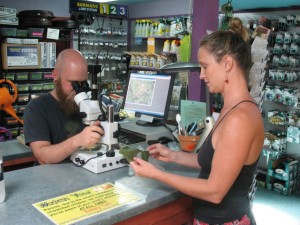Pest Diagnostic Centers Are Easier To Set Up Than You Might Think
 For customers, garden centers can be an intimidating place. Add into that mix the plant they bought that’s now wilted, spotty or distressed, and you have a recipe for disaster.
For customers, garden centers can be an intimidating place. Add into that mix the plant they bought that’s now wilted, spotty or distressed, and you have a recipe for disaster.
That’s where plant diagnostic centers can turn the negative into a positive educational experience and recommend a course of treatment.
The garden center staff become plant doctors providing “prescriptions” for a healthier plant. And while many garden centers have staff members who do this on a daily basis, there are some retailers that formalize the process into designated areas with specialized equipment for diagnosing plant problems and recommending solutions.
Two such retailers graciously agreed to share their procedures with us for this story: Chalet in Wilmette, Ill., and The Natural Gardener in Austin, Texas.
These are two very different operations. Chalet is diversified in landscape and nursery operations as well as the garden center, and operates a gift shop, pet segment and even a 183-acre farm. Meanwhile, The Natural Gardener has long been the embodiment of organic and natural gardening and features acres of display gardens, animals and even a labyrinth for meditation.
Each, however, has a detailed, focused plant health and diagnostic center that educates customers and solves problems.
Diagnostic Centers Make You Credible
Just by having a diagnosis center, you emphasize your trust factor.
“It’s a huge sales tool for us at a time even when plants sales are slow,” notes Lyda Guz, managing director at The Natural Gardener. “It brings them to our store because we are problem-solvers. We are treated very much like our local extension, except the people know they’ll get organic solutions from us.”
Jennifer Brennan, horticulture information specialist at Chalet, agrees that a plant diagnostic center elevates the status of the garden center to more than just the local retailer. It becomes the go-to place for information and products. And once customers see the insect or disease for themselves via a camera on the microscope that projects the image to a computer screen, they are more than willing to purchase something to get rid of it.
“We have converted a lot of people. You show them what they can use on their problem and they buy it immediately – that’s why we keep the diagnosis free,” says Brennan.
Why Pest IDs Convert To Sales
During the peak season, Chalet receives as many as 25 to 30 requests for diagnosis a day. “I would say 65 percent to 70 percent of the time people buy the product on the spot,” says Brennan.
But even if they don’t buy right then, or if the problem isn’t pest or disease related but more a cultural issue like wrong plant, wrong place, the customer still understands the staff at the local garden center knows its stuff.
For Rosina Newton, horticulturist and education coordinator at The Natural Gardener, it’s not enough to just make the diagnosis.
“I will walk them over to the product and it depends on the customer. If they’re experienced gardeners, sometimes they don’t want a lot of talk. But more often than not they want the complete story,” she says. “It’s so satisfying to know they’ve never gotten this information from anywhere before and this is going to make them more successful.”
What You Need To Have Your Own Diagnostic Center
So what does it take to create your own plant health destination in your garden center? Next we’ll break down the costs and procedures of both garden centers to show you the investment of creating a center and the staffing involved in maintaining it.
A Close Look At Chalet’s System
The Plant Health Care Center at Chalet is part of an approximately 500-square-foot room within the garden store that includes all of the pest and disease solutions. The room is ventilated well to remove odors, and features bookshelves full of reference guides, as well as a microscope with a camera hooked up to a computer and monitor.
The Equipment
Chalet purchased both pieces of equipment from Troxell Communications in Phoenix, Ariz., a company that provides price breaks for educational equipment.
- A Ken-A-Vision T-2400 Stereo Microscope with 20X eyepiece cost $125 in 2006. (A quick online search shows similar microscopes range from $100 to $550 today)
- The accompanying camera, an AverMedia AverVision 130 Document camera, ran $479 in 2006. (Prices today are in a similar range, a quick online search shows.)
- The flat screen monitor cost $280 in 2006.
Additional costs include reference materials (see the sidebar on resources for more details) and Chalet-branded notepads that include room for the host plant, symptoms, diagnosis, control recommendations and customer name and phone number. The notepads are stand ins when no one is available to make a diagnosis. Customers place their sample in a baggie and attach the notepad with their contact information for a return phone call.
Labor Needed
Horticulturist and retail manager Tony Fulmer and Brennan train staff members before peak spring during two separate sessions called Chalet College. Employees are trained on how to use the microscope and what to look for with regard to pests and diseases. Samples are kept and dried as examples to train staff members, and during the season Brennan does “show and tell” training sessions during weekly meetings when interesting specimens arrive.
Brennan has made it part of her job to staff the Plant Health Care Center from 1 to 2 p.m. every day, and she and Fulmer are on-call via radio when they are on site.
How The Natural Gardener Runs Its Center
The Information Center at The Natural Gardener is located in the back of the retail store. The desk has two sides for the customer to approach and takes up a 100-square-foot area in a 900-square-foot room, surrounded by natural and organic soil amendments, pest and disease solutions, tools, and more. The area includes a two-tiered desk that is ADA compliant on one side and chest-height on the other. Owner John Dromgoole felt the Information Center was a natural extension of his organic gardening radio talk show, where callers have been getting free gardening advice for almost 30 years.
The Equipment
- An AmScope 3-D stereo microscope with 10X-20X lenses and camera with software that projects the image to a basic desktop computer and standard flat screen monitor cost about $500 in 2007.
- Multiple resource books and reference guides specific to Texas horticulture, as well as about 50 different kinds of plant and technical information sheets created by Newton vary in cost.
- Pest and disease issues are looked up in the resource books and via pre-vetted bookmarked websites on the computer.
Labor Needed
Newton is one of two horticulturists who help staff the Information Center, along with five other employees who are trained to use the equipment, research a diagnosis and recommend a solution. The second horticulturist, Jeff Ferris, also teaches the subject at the local community college.
The Information Center is staffed at all times and has become a vital part of the business, which focuses heavily on educating customers about organic and natural solutions.
For training, Newton encourages staff members to attend the free classes that are offered to customers. Regular mini-classes that last up to a half hour update employees on how to use the Information Center and how to help a customer achieve a diagnosis.
Newton has created “20 Questions For Diagnosing Plant Problems,” which in essence “triage” a plant’s problems to determine whether they are cultural or brought about by disease or pests. Employees are provided the 20 questions so they can help begin the diagnosis process.










